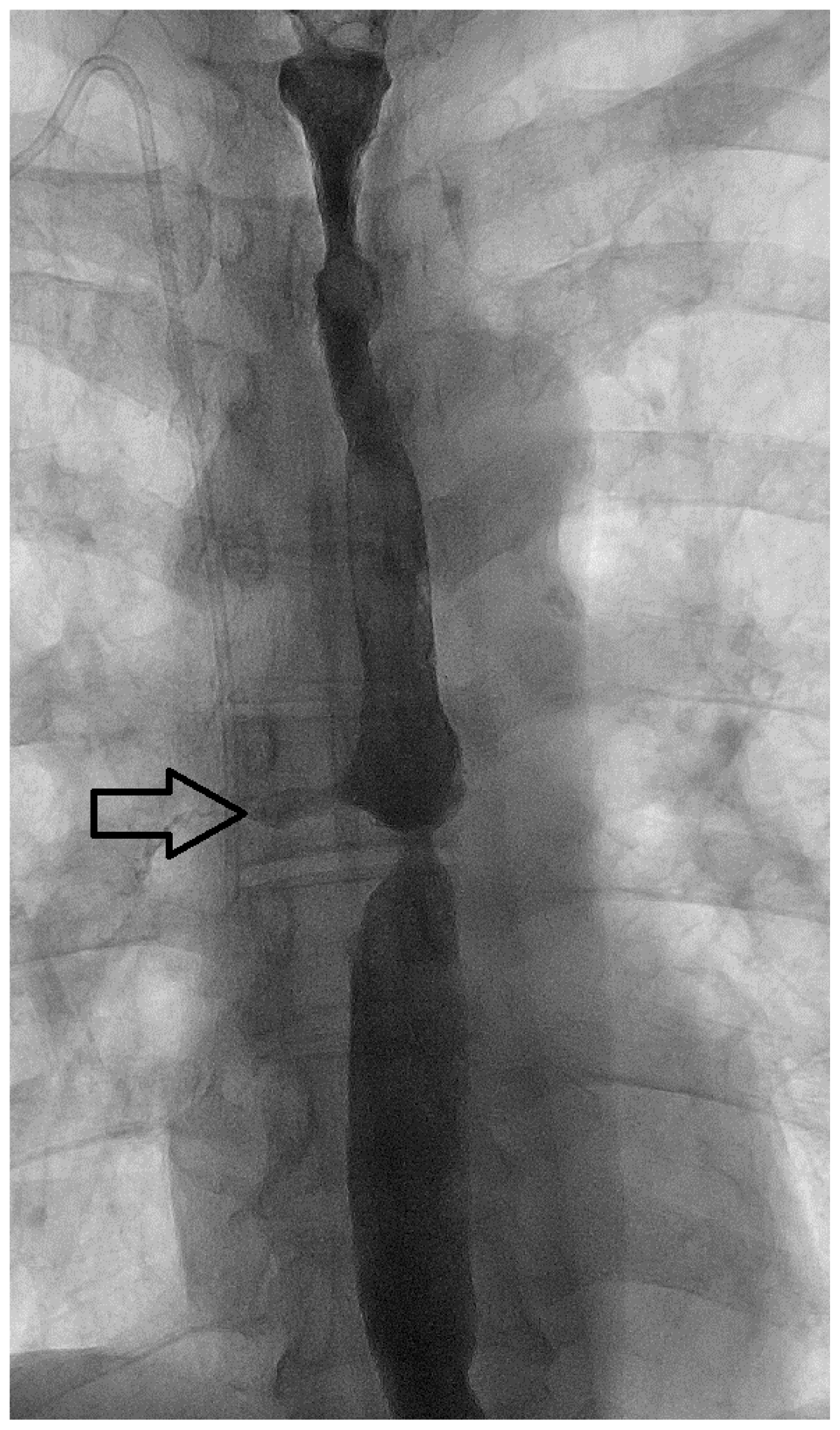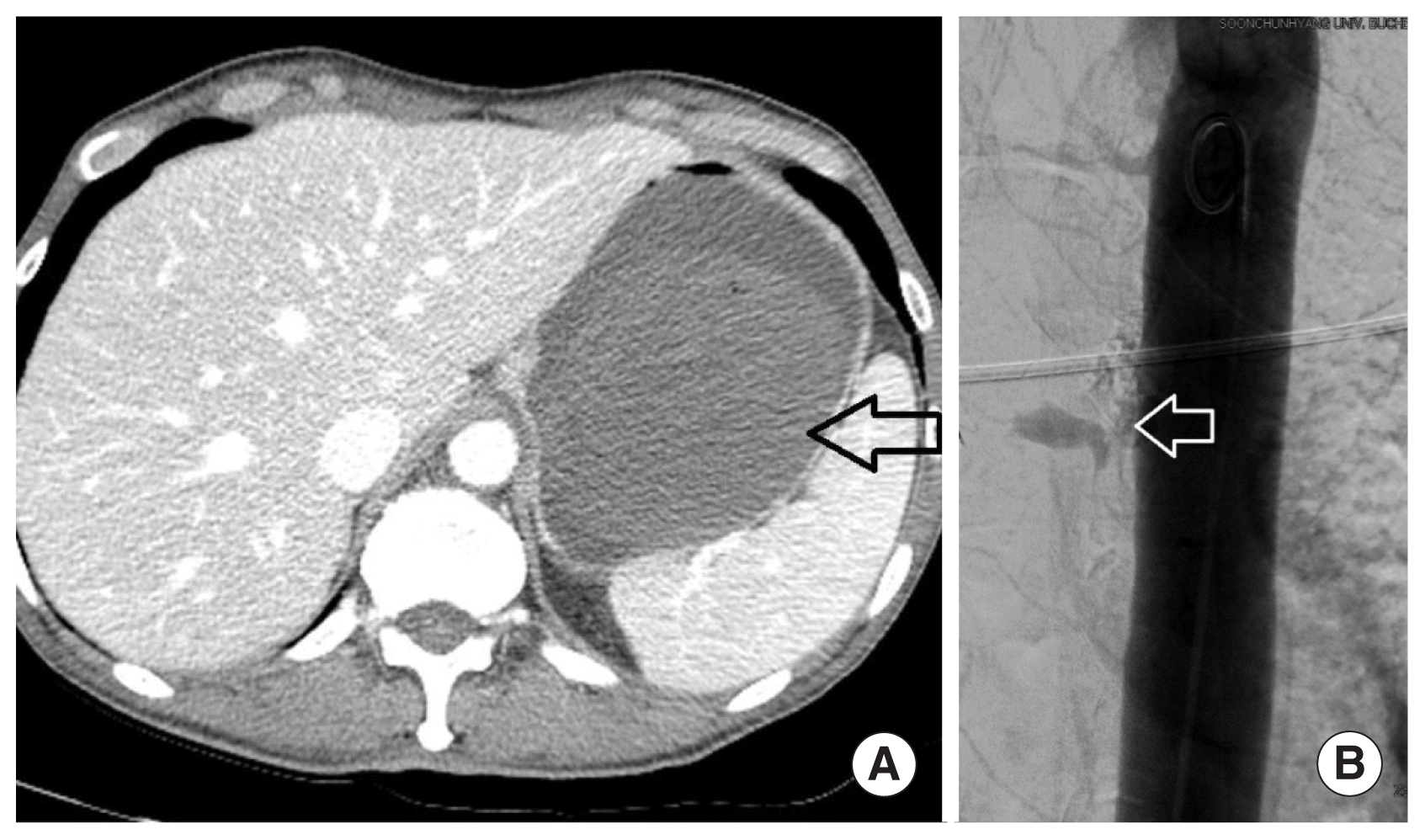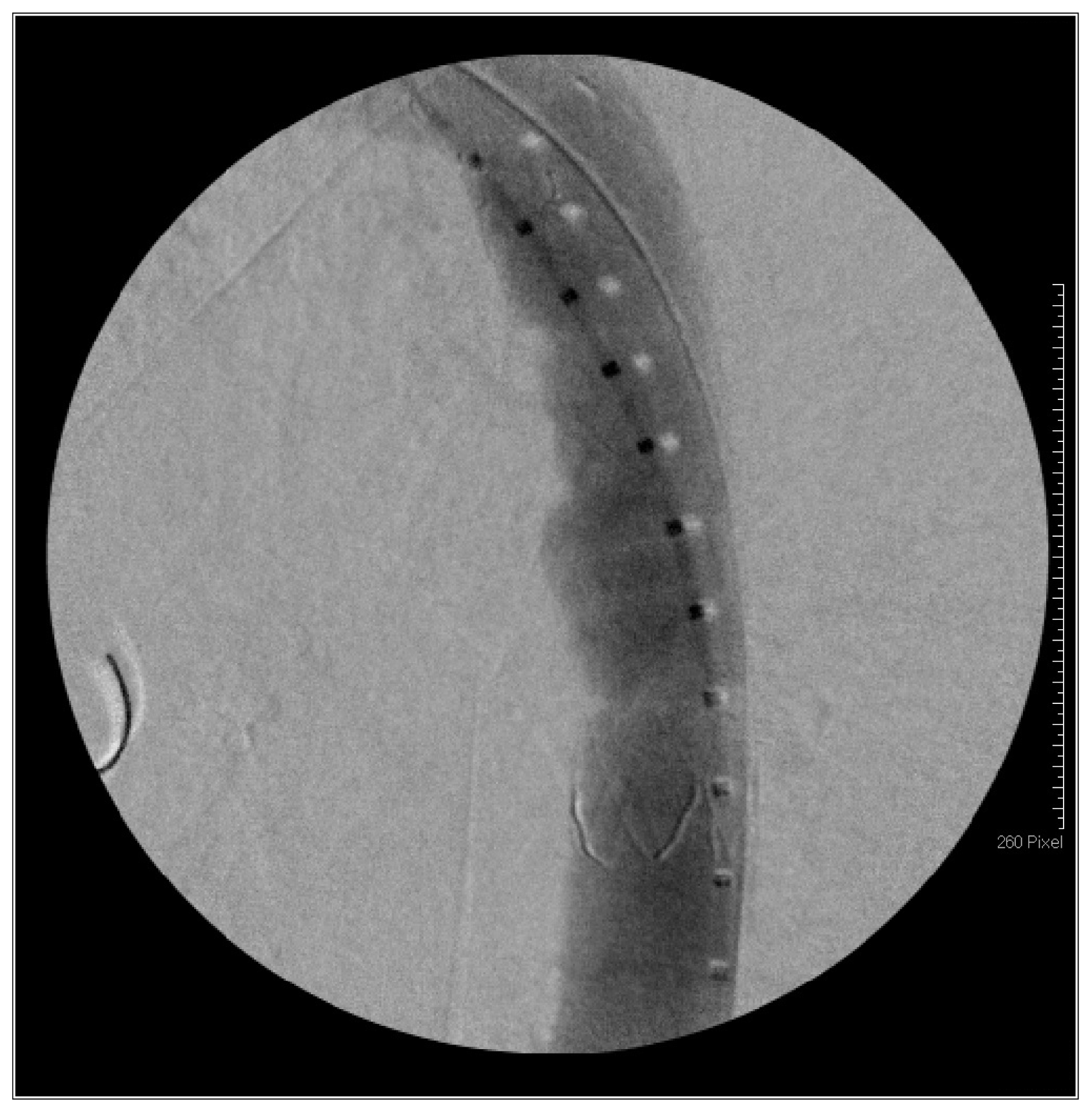INTRODUCTION
An aortoesophageal fistula (AEF) is a rare but fatal disorder that usually requires emergency surgery. Causes of AEF include a history of surgery on the esophagus or aorta, esophagitis, tuberculosis, trauma, and aortic aneurysm. Because AEF is accompanied by heavy bleeding in most cases, treatments involve emergency intervention (arterial embolization) or surgery, and do not vary according to the causes of the disorder. The usual surgical treatment of AEF includes extracorporeal circulation using cardiopulmonary bypass, therapeutic hypothermia for spinal cord protection, and other long and complex procedures with high rates of complications and mortality [1]. This study reports the case of a patient with esophageal cancer who developed a tracheoesophageal fistula after receiving radiotherapy, and later developed an AEF as a complication. Thoracic endovascular aortic repair, which is not a usual method of aortic surgery for AEF, was performed; radical esophagectomy and esophagogastrostomy were performed to treat the tracheoesophageal fistula and esophageal cancer. Although these procedures cannot completely replace palliative surgery, they may be considered for certain patients.
CASE REPORT
A 59-year-old man complained of 3 months of dysphagia and underwent endoscopy. He was diagnosed with squamous cell carcinoma of the upper esophagus, and started chemoradiotherapy. Two months later, esophageal endoscopy and esophagography were performed due to an increased amount of sputum and recurrent pneumonia, but a tracheoesophageal fistula was not observed. The symptoms of pneumonia waxed and waned, and a tracheoesophageal fistula was identified on esophageal endoscopy three months later. Interventional procedure, in which a plug was used to close the tracheoesophageal fistula, was performed, and the patient was discharged after sufficient improvement in pneumonia (Fig. 1). Ten days later, the patient complained of hemoptysis and abdominal discomfort. Computed tomography showed a large amount of blood inside the stomach. Interventional embolization was attempted for AEF (Fig. 2). Hemostasis could not be achieved due to the large size of the fistula and heavy bleeding. Because of intractable hypotension, thoracic endovascular aortic repair was performed. Because the patient went into shock due to cardiopulmonary collapse, aortography could not be performed prior to the thoracic endovascular aortic repair. A stent graft (A SEAL thoracic stent graft 30×100 mm; S&G Biotech, Seoul, Korea) was instead inserted below the root of the left subclavian artery. No bleeding was observed on subsequent aortography (Fig. 3).
The patient recovered from shock in the intensive care unit, and was monitored for bleeding. Over the following three days, no bleeding was observed; the patient’s condition improved and he was moved to a general ward. Because the rate of complications due to infection from a tracheoesophageal fistula are high, it was considered necessary to control mediastinal inflammation and improve the patient’s overall condition before attempting surgery on the tracheoesophageal fistula. The patient continuously received antimicrobial therapy while receiving total parenteral nutrition through a central vein, and remained fasting. The white blood cell count and laboratory findings of inflammation started to improve. Esophageal resection and reconstruction (esophagogastrostomy) were performed 45 days after stent graft insertion. Incision was made along the midline of the abdomen to prepare for esophagogastrostomy. Then, thoracotomy was performed. The entire esophagus was dissected and resected along with the surrounding lymph nodes. It was determined that esophagogastrostomy would be performed at the cervical level because the patient had signs of mediastinitis, and the esophageal cancer was located near the upper azygos vein. Although a tracheoesophageal fistula was not clearly observed, the previously inserted plug was located and removed, and the fistula was sutured. The thoracic surgery was terminated after the sutures were reinforced. The cervical esophagus and lymph nodes were dissected and resected via an incision in the left neck. To secure a sufficient resection margin for the esophageal cancer, esophagogastrostomy was performed in the proximal direction. During 12 hours of monitoring after surgery, the patient did not show any complications, and was moved to a general ward. Esophagography was performed 7 days after the surgery. No leakage at the esophagogastrostomy was observed. The patient was placed on a soft diet. No cancer cells or metastasis were identified on histological examination. The patient was discharged 35 days after surgery without incident. The patient has not complained of complications other than intermittent dysphagia, and has been monitored for one year as an outpatient.
DISCUSSION
While an AEF is a rare disorder, it is lethal and usually requires emergency surgery. An aortic aneurysm is the most common cause of AEF. Therefore, the usual treatment of AEF involves extracorporeal circulation for the aortic aneurysm and suture and reconstruction of the esophageal fistula. However, since AEF is usually accompanied by mediastinitis, patients may be vulnerable to infection during surgical treatment of an aortic aneurysm using synthetic vascular grafts, and this vulnerability has been linked to death [2]. Numerous recent reports have described the use of aortic stent grafts [3,4]. However, there are also reports that aortic stent grafts may cause an AEF [5]. In addition, an AEF is comorbid with mediastinitis in most patients, and infections can worsen AEF. Therefore, aortic stent grafts may not be the best choice for all patients. However, our patient could not undergo extracorporeal circulation due to worsening hypotension, and thoracic endovascular aortic repair was the only option. In addition, AEF is caused by a disorder of the aorta rather than the esophagus in most patients who undergo insertion of a stent graft into the AEF. The cause of AEF in this patient was not an aortic aneurysm, but esophageal cancer, which was aggravated by mediastinitis due to a tracheoesophageal fistula that developed after radiotherapy. We had previous experience in treating AEF caused by tuberculous esophagitis using similar procedures, and determined that the cause of the AEF was not an aortic aneurysm, but an esophageal diverticulum in this case [6]. Following closure of the AEF with an aortic stent graft pending esophageal reconstruction, complications due to mediastinitis must be prevented with antimicrobial therapy. Since there is no guideline or report on the duration of antimicrobial treatment, the course of therapy must be determined by the clinical symptoms and blood test results. In our patient, antimicrobial therapy was continued until the white blood cell count, erythrocyte sedimentation rate, and C-reactive protein levels returned to normal, and fever, tachycardia, and hypotension resolved. It was felt that recovery from an esophageal fistula that developed after chemoradiotherapy would be slow, and the patient therefore underwent 45 days of fasting and antimicrobial therapy. Surgery was subsequently performed for radical esophagectomy for the esophageal cancer and closure of the tracheoesophageal fistula. The fistula was located by the previously inserted plug, and was sutured. During esophagogastrostomy of the thoracic esophagus, a sufficient resection margin could not be secured because the esophageal cancer was located near the azygos vein. And since blood is supplied to the thoracic esophagus by branches off the aorta, unlike in the cervical esophagus, blood flow is stopped when an aortic stent graft is inserted, and this may hinder healing in the region where the esophagogastrostomy was performed. In a previous patient who developed an AEF after tuberculous esophagitis, a fistula developed on the anastomosis site, and endoscopic repair was necessary [6]. Accordingly, it was decided that cervical esophagogastrostomy was the best choice, despite the possibility of dysphagia after the operation.
Use of aortic stent grafts in the treatment of AEF has been controversial. Generally, when an aortic stent grant is inserted in a patient with AEF, the space in the false lumen fills with blood clots, and the space becomes smaller as the clots are absorbed. However, infections tend to persist in patients with an AEF, and since an aortic stent graft lacks elasticity and has a larger diameter compared to the normal aorta, it may apply pressure on the mediastinum. The aortic stent graft may irritate the esophagus, and worsen the AEF [7]. For these patients, extracorporeal circulation, removal of the aortic stent graft, and bypass surgery must be performed [7,8].
Tracheoesophageal fistula may be caused by congenital factors, injury, inflammation, and neoplasm. AEF in adults is mostly associated with neoplasm [9]. A small tracheoesophageal fistula may be repaired through an endoscopic or interventional procedure. However, a recurrent tracheoesophageal fistula or one larger than 1 cm requires surgical treatment. In addition, it is difficult to expect complete closure of a fistula caused by neoplasm using interventional procedures [9]. Therefore, a tracheoesophageal fistula in esophageal cancer patients requires surgical treatment in most cases; when accompanied by serious complications, as in the present case, close monitoring following surgery is necessary.
In this case report, endovascular aortic repair was performed as the initial treatment of AEF caused by esophageal cancer. While the possibility of later complications due to the aortic stent graft must be considered, thoracic endovascular aortic repair has clear advantages, in that it can accurately and rapidly stop bleeding when symptoms worsen and lead to shock, as in the present case. Thoracic endovascular aortic repair should be the preferred method of treatment for an AEF caused by esophageal cancer rather than aortic aneurysm.














